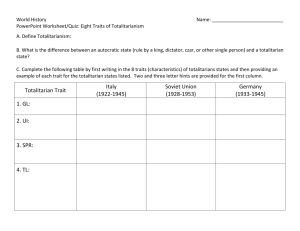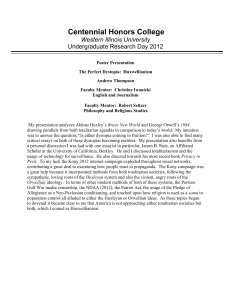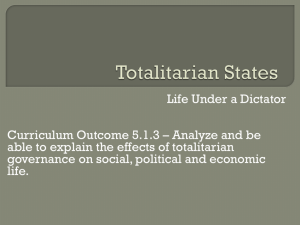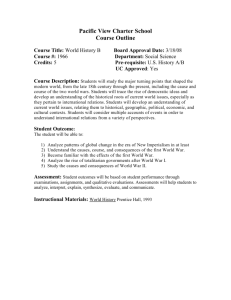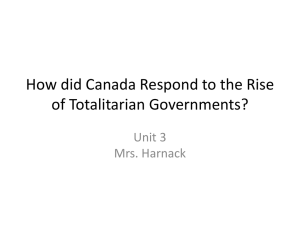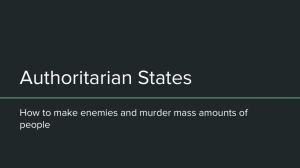Alex McNeil 10/15/15 History of Totalitarian Regimes Identity and Agency in Totalitarian Regimes
advertisement
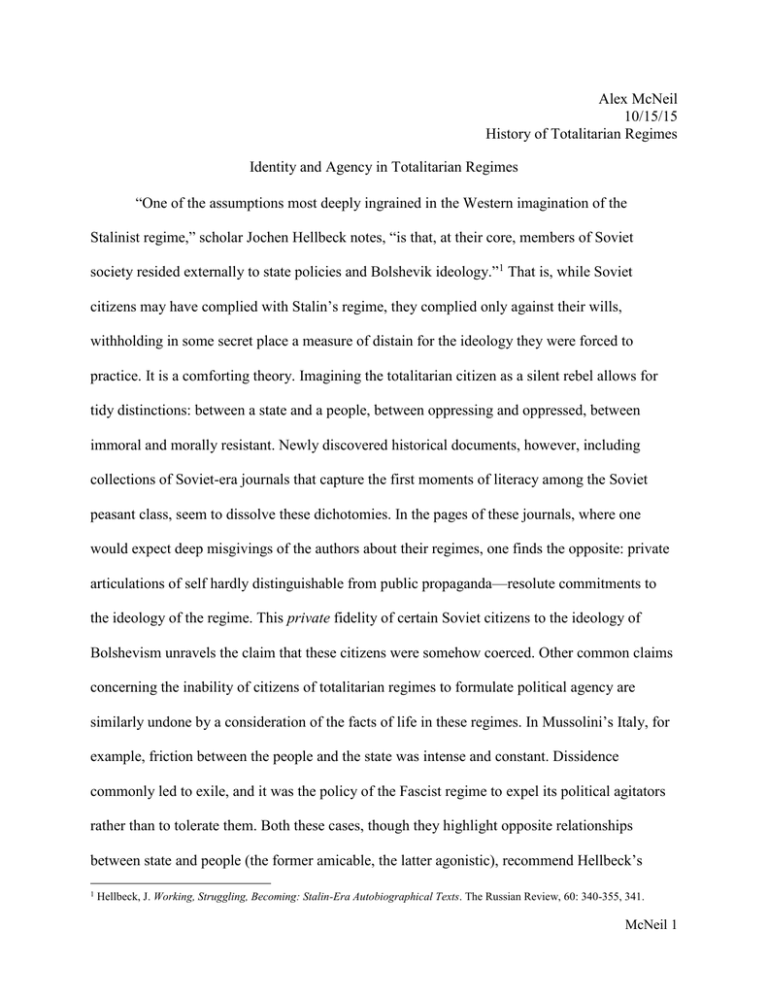
Alex McNeil 10/15/15 History of Totalitarian Regimes Identity and Agency in Totalitarian Regimes “One of the assumptions most deeply ingrained in the Western imagination of the Stalinist regime,” scholar Jochen Hellbeck notes, “is that, at their core, members of Soviet society resided externally to state policies and Bolshevik ideology.”1 That is, while Soviet citizens may have complied with Stalin’s regime, they complied only against their wills, withholding in some secret place a measure of distain for the ideology they were forced to practice. It is a comforting theory. Imagining the totalitarian citizen as a silent rebel allows for tidy distinctions: between a state and a people, between oppressing and oppressed, between immoral and morally resistant. Newly discovered historical documents, however, including collections of Soviet-era journals that capture the first moments of literacy among the Soviet peasant class, seem to dissolve these dichotomies. In the pages of these journals, where one would expect deep misgivings of the authors about their regimes, one finds the opposite: private articulations of self hardly distinguishable from public propaganda—resolute commitments to the ideology of the regime. This private fidelity of certain Soviet citizens to the ideology of Bolshevism unravels the claim that these citizens were somehow coerced. Other common claims concerning the inability of citizens of totalitarian regimes to formulate political agency are similarly undone by a consideration of the facts of life in these regimes. In Mussolini’s Italy, for example, friction between the people and the state was intense and constant. Dissidence commonly led to exile, and it was the policy of the Fascist regime to expel its political agitators rather than to tolerate them. Both these cases, though they highlight opposite relationships between state and people (the former amicable, the latter agonistic), recommend Hellbeck’s 1 Hellbeck, J. Working, Struggling, Becoming: Stalin-Era Autobiographical Texts. The Russian Review, 60: 340-355, 341. McNeil 1 rejection of the common notion that “all political initiative was monopolized by the revolutionary state, and revolutionary politics by their very nature undercut the production of stable identities.”2 By drawing on examples from the Soviet and the Fascist regimes, this essay will explore the ways in which citizens were able to seize political agency and to create stable forms of selfhood even in the managed spaces of totalitarian regimes. These cases will lay the groundwork for a later inquiry into the presumptions made by Western liberal scholarship that deals with concepts of autonomy and personhood in totalitarianism regimes. One common supposed characteristic of totalitarian regimes is their tendency to oppress the identities of their citizens—to drown out the expression of genuine individuality with the thrum of the totalitarian propaganda machine. This perspective is challenged, however, by diaries kept by members of the Russian peasant class that reflect the formation of individual identities during and directly after the Soviet revolution, and that show the similarities between the private and public identities of Soviet citizens. One of the main purposes of the diaries, according to Hellbeck, was to act as a place of reconciliation between the microcosmic experience of the individual-within-revolutionary-society and the macrocosmic struggle of the revolution and the regime.3 The diaries provided Russian peasants with an opportunity to situate themselves in revolutionary time, as agents of profound revolutionary change. “For the most part,” Hellbeck writes “[diaries] were kept on the initiative of the authors, who in fact often deplored the absence of official precepts of self-transformation according to which they could pattern their lives. An investigation of this diary literature thus highlights the extent to which individuals, acting on their own, creatively wove themselves into a loose matrix of 2 3 Hellbeck, Working, Struggling, Becoming: Stalin-Era Autobiographical Texts. 342. Ibid. 343. McNeil 2 subjectivization produced by the revolution.”4 In many diaries, this ‘subjectivization’ took the shape of a personal narrative that employed the language and mindset of the Bolshevik ideology. One journal entry, written in May of 1933 by a Dnevnik Zhelezniakova, illustrates the tone and mood of these revolutionary journal entries: …there were many victories and defeats. the class enemy, the kulak, did not sleep, organizing the backward mass of the bedniaki (poor peasants) and seredniaki (peasants of average means) against the kolokhoz. …Thus, in a bitter skirmish with the obsolete and dying capitalist elements, our kolkhozes have been born, rendered, and strengthened. A lot of struggle still lies ahead, especially at the new location…where I have been transferred by the district committee of the party.5 This entry comes across much like what one might expect from a piece of state-sanctioned propaganda. However, it is not. That the private space of Dnevnik’s journal (and the journals of many of his contemporaries) was reserved for the articulation of a form of selfhood that so closely resembles the ideological language of Bolshevism is significant. It erodes the notion that Russian peasants merely feigned their support for the Soviet regime, suggesting instead that individuals in Soviet society held a genuine belief in Bolshevik ideology that transgressed the boundary between their public and private selves. Another claimed characteristic of the totalitarian regime is its tendency to render citizens politically inert through the application of propaganda and terror. Terror, especially in the Soviet system, was one of the the sharpest and most liberally wielded items in the totalitarian toolbox. In Hitler, Stalin, and Mussolini: Totalitarianism in the Twentieth Century, historian Bruce Pauley describes the collectivization of Russian farms (and the concurrent purge/reorganization of Russian society) that occurred in the late 1920s as “nothing if not a gigantic act of terror in 4 5 Hellbeck, Working, Struggling, Becoming: Stalin-Era Autobiographical Texts. 345. Ibid. 346. McNeil 3 which millions of Russian peasants were killed or imprisoned and nearly all the rest were traumatized.”6 While the purges of Russian society enacted by Stalin had an arbitrary quality, often targeting loyal members of the Soviet party, the purges had the effect of stunning potential dissidents into compliance. According to Pauley, “the purges were a pre-emptive strike against anyone with a power base or any trace of independent thought.”7 State terror also existed in Fascist Italy: “Mussolini, too, had the power to purge and his party secretaries resorted to it thousands of times… The explosions from the Fascist party demonstrated that members had to be careful with their speech and actions…”8 In “The years of consent? Popular attitudes and resistance to Fascism in Italy, 1925-1940” Fascist scholar Philip Morgan argues that, although the body counts were lower in Fascist Italy than in Soviet Russia, “the cliche that Fascist Italy was somehow less repressive than Nazi German or Stalinist Russia cannot really be justified in the face of the extent of policing and its efficiency.”9 High volumes of trials in Fascist Italy by military tribunal during the 1930s indicate, Morgan contends, the incredible threat the Fascist government posed to its political dissidents.10 Despite the extensive control exercised by totalitarian states on their subjects, political dissent and protest were alive and well in totalitarian regimes such as Mussolini’s Fascist Italy. Admittedly, according to Morgan, most “forms of protest bore the imprint of the routine repressiveness. Most…were micro-incidents, small in scope, short in duration, local in setting…”11 Nevertheless, deliberate and deliberative protest did take place: “Protests occurred on holidays or after Sunday mass, occasions when the coming together of groups of people was 6 Pauley, B. Hitler, Stalin Mussolini: Totalitarianism in the Twentieth Century, 3rd edition. 162 Ibid. 164 8 Ibid. 173 9 Phillip, M. “The years of consent? Popular attitudes and forms of resistance to Fascism in Italy, 1925-1940.” Opposing Fascism. P. 163-179. 167. 10 Ibid. 167. 11 Ibid. 175. 7 McNeil 4 unlikely to provoke an exceptional police presence. Women were prominent…to soften or deflect police intervention.”12 Other forms of protest, such as “anti-Fascist and pro-Communist slogans;… scurrilous jokes and puns scrawled in public and factory toilets; [workers] singing the ‘Internationale’ as they walked to work at dawn,” were common in Italy during the era of Mussolini’s Fascism.13 These examples of protest, although often minor and failing to produce much result, nevertheless demonstrate the incomplete power of propaganda and terror to eliminate the formation of divergent political agency within totalitarian communities. Our inquiries into Soviet Russia and Fascist Italy have demonstrated the possibility for the formation of identity and the articulation of political dissent in even the restricted space of the totalitarian state. The two sub-groups we have examined—Russian peasants in Soviet Russia and common protestors in Fascist Italy—embody very different attitudes toward their ruling government and ideology. Interestingly, it is the group more prone to extremely brutal reprisal— the Russian peasants—that showed higher levels of fidelity to the government and ideology of their parent regime. In the Russian case, we tried to undo the common Western narrative of political dissent in the private sphere, substituting in its place an understanding of private Russian identity that more or less comported with the highly ideological public identity demanded of Soviet citizens by the Soviet regime. In the Italian case, we unpacked moments where an ostensibly agency-less Italian public demonstrated clear political resistance in the form of protest. Is there an ideological component to the claims that the identities of totalitarian citizens were false as opposed to genuine, or that, to use Hellbeck’s language, “all political initiative [of 12 13 Ibid. 176. Ibid. 177. McNeil 5 the totalitarian citizen] was monopolized by the revolutionary state”?14 The majority of the history of 20th century totalitarianism has been written by scholars either naturalized or acculturated into the mindset of liberalism. One must assume that flavor of liberalism has been suffused into the study of totalitarianism. At certain moments in the scholarly or philosophical construction of the imagined totalitarian citizen at which the liberal mindset seems most apparently imposed. In her essay “The Tenacious Liberal Subject in Soviet Studies,” Anna Krylova gestures to several of these—places where contemporary liberal values are projected onto the totalitarian past. According to Krylova, the turn in Soviet scholarship to the “neoindividualistic” liberal perspective of the totalitarian citizen was “[an] intellectual shift [which], in turn, circumscribed interpretive possibilities [of the Socialist subject] within a set of binary categories: indoctrination/resistance, belief/disbelief, faith/cynicism.”15 These dichotomies were the desiderata of an audience of American Soviet scholars busily combing through history in search of “remnants of liberal subjectivity and signs of resistance against antiliberal communist Russia.”16 The search for a ‘liberal subjectivity and signs of resistance’ extended, it seems, to the realm of political philosophy, as well. One concrete example of the reinscription of a liberal framework into totalitarian thought can be found in political philosopher Hannah Arendt’s essay “The Public and the Private Realm,” wherein Arendt outlines the process by which, in the absence of a heterogenous political community, the social fabric of society unravels into its constituent threads, a collection of socially isolated individuals: …it may also happen under conditions of mass society…where we see all people suddenly behave as though they were members of one family, each multiplying and prolonging the perspectives of his neighbor. In both instances, men have become…all 14 Hellbeck, Working, Struggling, Becoming: Stalin-Era Autobiographical Texts. 342. Krylova, A. The Tenacious Liberal Subject in Soviet Studies. Kritika 1/1 (Winter 2000): 119-46. 2. 16 Ibid. 8. 15 McNeil 6 imprisoned in the subjectivity of their own singular experience, which does not cease to be singular if the same experience is multiplied innumerable times.17 There is a surprising atomization and loneliness in Arendt’s ‘mass society’—a society that one might imagine would provide the highest possible degree of commonality, shared belief and solidarity to its members. In her essay, Arendt does not explicitly address such an imagined political community as “totalitarian,” yet this quote seems illustrative of what a Westerner might imagine to be the state of social relations in the monological political community of the totalitarian state. Arendt’s perspective on isolation presupposes a forced-ness—a coerced rather than a willing adherence to a single pole of total ideology. If Arendt were to presume, instead, a profound enthusiasm (the sort illustrated in the case of the Soviet journals) of totalitarian citizens toward their governing ideology, perhaps she would arrive at an altogether different (and less cynical) conclusion about the nature of certain totalitarian political communities. All this is to say is that the body of Western history and philosophy that concerns the totalitarian state is perhaps vulnerable to the criticism that its authors approach the subject from a biased perspective, a viewpoint inflected with the political timbre of the liberal tradition. The examples of the Soviet journals, of resistance in Fascist Italy, represent moments of dissonance between documented fact and the Western liberal narrative. These moments ask us to consider the possibility that, just as totalitarian citizens were (so we assert) blinded by ideology, so we may have been: guided by our liberal bias to a narrow and inflexible position on the nature of selfhood and agency in the totalitarian past. 17 Arendt, H. The Public and the Private Realm. The Human Condition. Yale, 1987. P 43-79. 58. McNeil 7
